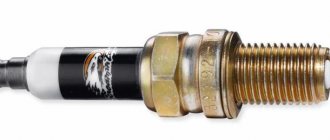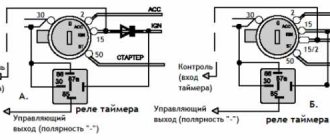Experienced car owners know very well that the condition of the spark plugs can determine engine malfunctions and the general condition of the power unit. We will tell you in more detail about how the condition of the spark plugs can reveal the presence of certain malfunctions in the engine.
Red candles
If the spark plugs have red soot, this indicates the use of low-quality fuel with a large number of different additives. Such additives are most often made on the basis of metal oxides, which gives such a characteristic red tint. Long-term use of low-quality fuel can lead to critical engine malfunctions, so you should think about changing the gas station.
The nuances of performing engine diagnostics based on the condition of the spark plug
Experts who work in the field of vehicle diagnostics and repair recommend performing visual inspections at certain intervals. The fact is that by the appearance of this component it is possible to determine what condition the motor is in and, as a result, carry out repair work in a timely manner.
If you neglect this procedure, a situation may occur when the engine stops working, and the repair process will be very expensive. Quite often, to determine the technical condition of a vehicle, it is necessary to look at the presence of carbon deposits on the surface of the part. The presence of carbon deposits, as well as the color of the part, allows you to determine whether the spark plugs are working or not.
By studying the photo and description of carbon deposits on spark plugs, you can learn about most of the problems that exist in the car. If, after driving three hundred kilometers, the component that supplies the spark is brown, then you don’t have to worry about the fact that there is any malfunction. In this matter, we can safely say that the technical condition of the engine is in good working order.
In some situations, the color of the part is white or gray. If, when performing diagnostics based on the color of the spark plug, it was revealed that the components have a light shade, then we can conclude that there are problems associated with the mixture of fuel used. Here we are talking about the fact that the exhaust valves have failed, and there is also quite strong overheating in the combustion chamber.
That is why it is impossible to delay repair work. Experts recommend contacting a service station almost immediately. If the color is red, then this indicates quite large iron impurities present in the fuel liquid. As a result, they will cease to function completely.
Condition of spark plugs by appearance
Presence of white and black plaque
If white and black deposits are simultaneously observed on the spark plugs, this may indicate wear on the piston rings. Such repairs will require a complete opening of the engine; such an engine restoration falls into the category of major repairs, and accordingly the cost of the work will be quite high.
Let's sum it up
The car owner should remember that the technical condition of the engine can be determined by the condition of the spark plugs. For example, a white or black coating indicates a lean or over-rich mixture; if there are oil leaks, then there are problems with the valve stem seals, and a red coating on the spark plug electrode indicates low-quality fuel. Remember that the sooner you contact the service, the easier it is to fix such breakdowns. Therefore, you should regularly unscrew the spark plugs and check their condition, which will eliminate any problems with the engine or promptly determine any breakdowns it has.
14.06.2020
How to determine the condition of the engine by the spark plug
If the engine is running unstable, it is necessary to inspect the spark plugs. An experienced driver knows that the appearance of a spark plug can tell a lot about the condition of the engine. Before unscrewing the spark plug, thoroughly clean the area around the spark plug from dirt so that dirt does not get into the cylinder.
Look at the photos and remember what the spark plug looks like under different engine conditions.
Photo 1 shows the normal condition of the candle. Gray-brown color and minor wear on electrodes. The glow value of the spark plug corresponds to the type of engine and its general condition.
The second photo shows a candle with black carbon deposits on the insulator skirt. This indicates an over-enriched mixture and increased fuel consumption. The carburetor is incorrectly adjusted or the injector is faulty. The air filter may be clogged.
The third photo shows the condition of the spark plug with an excessively lean air-fuel mixture. The color of the electrode is from light gray to white. This is a dangerous condition. When driving with a very lean mixture and increased loads, significant overheating of both the spark plug itself and the combustion chamber occurs, which can lead to burnout of the exhaust valves.
In photo 4, the skirt of the central electrode has a reddish tint, similar to a brick. This color of the skirt is due to the presence of a large number of additives containing metal in the fuel. Long-term operation of the engine on such fuel will lead to spark plug failure, since the thick coating from the additives conducts electric current.
The candle in photo 5 is oily, this is especially noticeable on the threaded part. This indicates that the oil reflecting caps are worn out. An engine with such spark plugs usually stalls after starting and a white-blue exhaust from the muffler is noticeable, but as it warms up, the performance stabilizes. The engine consumes more oil than normal.
This spark plug (photo 6) was removed from a non-functioning cylinder. The skirt and central electrode are covered with oil, droplets of unburned fuel and metal particles. This may be due to valve damage or piston damage. When the engine is running, it revs all the time, power drops significantly, and fuel consumption increases by one and a half times.
If every woman tried this, stores with expensive dresses would go bankrupt!
In photo 7 we see the complete destruction of the central electrode along with the ceramic skirt. This occurs due to prolonged engine detonation when using low-octane gasoline. The cause may also be very early ignition. The candle may also be defective. Naturally, when the engine is running, it throttles.
In photo 8 , the spark plug electrode is overgrown with ash deposits.
They can be either white or black. This happens when the oil scraper piston rings are severely worn or stuck. As a result, increased oil consumption is observed. When re-gasping, strong smoke similar to motorcycle smoke comes out of the exhaust pipe.
How to diagnose spark plugs using photos
By studying photos of spark plugs, it is possible to perform diagnostics. Inspection of a component should be performed after it has been in operation for an extended period of time. Ideally, the inspection will be carried out after the vehicle has been driving on a country highway for a long time.
One of the problems for car owners is when they make a mistake when performing diagnostic work on their own. Here we are talking about a situation when, after starting the engine at a negative temperature, the spark plugs are initially unscrewed, and then it is determined that they are black.
You can guess that the person is drawing a conclusion about the wear of the component. In fact, black carbon deposits can appear during engine operation during a “cold” start. Thus, experts recommend drawing any conclusions only after the vehicle has driven at least 150 kilometers. It's even better if the distance is large.
Spark plug
Condition of the candles
So, let's try to figure out how to determine the condition of the engine from photos of spark plugs. If this component is in fully working condition, the appearance of the electrode will be brown. In turn, the presence of soot will be practically absent. There will also be no oil marks.
People whose car has a similar engine can be confident in its technical condition. Most likely, the car will have minimal fuel consumption. You can also determine by color that the car has increased fuel consumption. The color of the candle will be black. The cause of deposits on the electrode can be an air-fuel mixture, as well as a clogged air filter.
If the color is light, then on the contrary, the mixture is very poor. In such a situation, there is reason to worry. Heavy loads become one of the reasons for engine overheating. In addition, the component itself can also overheat greatly.
If the component is red, this indicates that the vehicle has been running on gasoline for a long time, with a large number of additives contained in the metal. If you operate a car on such fuel for a long time, this leads to metal deposits and insulation of conductive deposits. In addition, there is a possibility that other components included in the motor’s design will fail.
Traces of oil
Often, when studying photos of working spark plugs, you can see that they have traces of oil fluid. A special concentration of such traces is located on the threads. A motor with such spark plugs, after a long period of inactivity, most often begins to “triple”. The main reason is the poor quality of the oil deflector type caps.
It is impossible not to talk about what a working spark plug looks like when it was removed from a cylinder that has stopped functioning. The electrode and skirt are covered with a very dense layer of oil fluid, which is mixed with drops of fuel fluid and small particles that are destroyed. The main reason for all this is the process of destruction of the valves, as well as a breakdown that occurs in the partition between the piston rings, as well as the seat.
Spark plug condition
Damage to spark plugs
By diagnosing spark plugs by appearance, you can see when a complete destruction of a component whose structure is made of ceramic occurs. One of the reasons for the situation when destruction occurs is the long-term operation of the engine, the use of low-quality fuel, as well as manufacturing defects.
There are also situations when ash deposits are present on the removed component. In this case, color does not play any important role. The fact is that the shade of the component can only speak about the functioning of the fuel system. The reason for this situation is the combustion of the oil fluid after the piston rings have worn out or become stuck. Such motors have increased oil consumption and also emit an unpleasant odor during operation.
It should be noted that problems of this type are quite common when operating vehicles. If you do not want the situation to worsen, it is recommended to regularly diagnose your car. Most often, experts recommend performing the engine diagnostic process after the car has driven 30 thousand kilometers.
Let us note that it is also important to contact automobile workshops that employ specialists with extensive experience. They know how to determine the engine's operation by the spark plugs and, accordingly, will be able to ensure trouble-free operation of your vehicle. Approach this issue responsibly; no difficulties or problems will arise in the operation of the car.
How can a fault be determined by the appearance of a spark plug?
Good afternoon Today's article is a visual guide that allows you to identify engine malfunctions by the appearance of the spark plugs. Below are instructions (with photos) that will help you determine the nature of the malfunction by the color and type of deposits on the spark plugs.
Over time, the spark plug electrodes on a working engine begin to become covered with a light brown or dark coating. In general, the wear of the electrodes occurs evenly, and, as in the case of threads, there should be no traces of oil or unburnt fuel on them.
Normal operation:
The spark plug is in good working order and can be reinstalled.
Brown and dark gray deposits on the electrode.
This is a common pattern when using fuel additives (such as fuel injector cleaners). In this case, light deposits may be observed on the spark plug.
Even if detected deposits indicate normal operation of the spark plug, it is recommended to check the gap between the electrodes and clean off deposits before installing it.
Ash deposits.
Light brown deposits covering the center and side electrodes. They are formed due to unburnt oil or fuel additives. If deposits form on one side of the spark plug, this indicates wear on parts in the upper part of the engine (valves, gaskets, cylinder head). If they are observed on the electrode, then this is a sign of wear on parts in the lower part of the engine (cylinder, piston).
Traces of oil/fuel.
Traces of oil on the spark plugs appear when it enters the combustion chamber.
Oil deposits that form on the spark plug interfere with the sparking process. Electrical energy reaches the electrode not through the arc in the spark plug gap, but through the oil. This situation usually indicates significant engine wear.
It is possible to clean these deposits, but without repairing the engine, it does not make much sense. 10-20 minutes of work and the candles will be in their previous condition again.
Carbon traces.
Soft, black, dry deposits on the spark plug.
Such deposits indicate an enriched air-fuel mixture, incorrect operation of the ignition system, or incorrect temperature conditions of the engine (too cold). They conduct current well and can disrupt the sparking process.
The spark plugs are too hot.
The whitish color of the insulator and the shell on the electrodes indicates that the engine operating temperature is too high.
In some cases, the color of the insulator may be gray or dark blue. Incorrect engine operating temperature, lean fuel mixture or incorrect valve timing may cause this condition. Pay special attention to possible disturbances in the composition of exhaust gases and engine overheating, which can also cause excessive heating of the spark plugs.
In conclusion, I recommend watching this video about the most common engine malfunctions that can be diagnosed by the condition of the spark plugs:
That's all for me today. I hope that the article is useful and now you can determine engine malfunctions by the appearance of the spark plugs. If you have any questions or want to supplement the article, write comments.
Recommendations and tips
Normal stable operation of the engine is impossible without a properly selected spark plug. A spark must form at the right time - before the piston rises to the very top and the gas is compressed to its maximum. Not earlier and not later. A spark that jumps out at the wrong time leads to increased emissions and unstable engine operation (troits, unstable idle speed, does not develop sufficient power).
Spark plug diagnostics
The average service life of a spark plug is 30 thousand kilometers, but a properly selected high-quality spark plug can work twice as long. The working life also depends on the material from which the electrodes are made, their quantity and type. For example, spark plugs with bimetallic electrodes work more reliably and last longer.
We learned how to determine the condition of the engine by looking at the spark plug. A spark plug is a very good indicator that allows you to instantly identify engine malfunctions. It is for this reason that experts recommend regularly checking their condition. This is usually done every 10-15 thousand kilometers.











